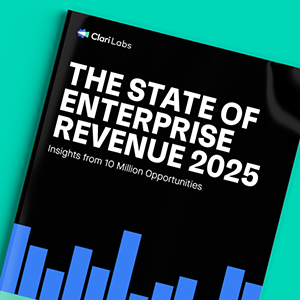Enterprises want to optimize their revenue operations (RevOps) and investments in revenue AI, while also engaging customers throughout the entire buying journey. But how can their revenue platform help them accomplish this? One of the most promising solutions to emerge is the Revenue Orchestration Platform (ROP). This is a revolutionary technology designed to provide a comprehensive solution for B2B sales orchestration as well as the complexities of modern sales teams. The goal of a revenue orchestration platform is to transform the way organizations align their sales, marketing, and customer success teams to maximize revenue potential; and global enterprises are quickly realizing that a ROP is a necessity for survival and predictable growth.
Understanding Revenue Orchestration
But what exactly sets revenue orchestration platforms and AI revops software apart from the other tools and solutions jockeying for position in an organization’s tech stack? And more importantly, how can revenue teams use them to address foundational challenges such as: fragmented data; siloed operations; and the lack of real-time insights?
In this article, we’ll define revenue orchestration and outline some of the key benefits of using a Revenue Orchestration Platform.
What separates the top performers from everyone else? Read the Clari Labs report to discover how revenue orchestration platforms can scale success across the entire revenue team.


Revenue Orchestration Platform Defined
Revenue Orchestration Platforms use AI to provide a centralized place to manage not only core selling activities, but a place to unify all outward facing functions including marketing and customer success. It further can enhance core opportunity data with buyer engagement and analytics from the entire go to market tech stack – giving teams a “single pane of glass” for all revenue-related activities.
A Revenue Orchestration Platform acts like the command center of an organization’s revenue generation. An ROP can take disparate pieces of tech and combine them throughout the entire buyer and seller journey into a unified place. In one platform, it brings together forecasting, conversational AI, sales coaching, chat, sales engagement, conversation intelligence, revenue operations, and deal management.
“ROPs enable B2B organizations to orchestrate and maximize commercial performance from their revenue motions, including new logo acquisition as well as renewal and expansion motions for existing customer relationships, according to Forrester. They allow individual sellers to orchestrate their own engagement while providing leadership and operations with insight on how to effectively orchestrate teams and the underlying processes supporting engagement and revenue management.”
Gartner has validated and consolidated capabilities across sales engagement, revenue intelligence, and SFA markets into a category called Revenue Action Orchestration (RAO). However, the ultimate goal of both RAO and ROP is to: use AI to improve sales productivity, facilitate decision-making, and help execute sales actions across multiple channels.
What’s the difference between Revenue Platforms and Revenue Orchestration Platforms?
A revenue platform is a centralized system, often software-based, that aims to streamline and optimize all aspects of revenue generation, from marketing and sales to customer service and billing. While both aim to boost revenue, Revenue Platforms (RSPs) focus on connecting the customer journey and bridging data gaps across these functions. Meanwhile, Revenue Orchestration Platforms (ROPs) rely heavily on AI to unify and optimize the entire revenue process, including sales, marketing, and customer success.
What is Revenue Operations Software?
Revenue Operations software or RevOps software is defined as a suite of tools and technologies designed to align and optimize sales, marketing, and customer success teams to drive revenue growth through improved processes, data, and collaboration. RevOps software is a key component of any revenue orchestration platform, because it provides the tools and data to streamline processes, improve data accuracy, and enhance collaboration.
The benefits of RevOps software:
Streamlined Revenue Processes
Whether it’s generating leads or improving customer retention, RevOps software streamlines the entire revenue cycle by optimizing processes and using reliable data.
Aligned Teams
By breaking down silos between sales, marketing, and customer success teams, Revenue Operations software fosters better collaboration and communication.
Improved Efficiency
By automating tasks, integrating data, and providing insights RevOps software leads to increased efficiency and productivity.
Data-Driven Decisions
Revenue Operations software centralizes data and provides valuable analytics to enable better strategy and execution.
Predictable Growth
The ultimate goal of RevOps is to use data to achieve scalable, predictable growth.
How a Revenue Orchestration Platform works
An effective Revenue Orchestration Platform has the ability to guide sellers, while improving buyer and customer journeys and sales processes right within a seller’s workflow. It goes beyond outlining the path — it equips sales teams with the right content, insights, and actions to address buyer needs at every stage of the sales cycle.
By replacing uncertainty with data-driven decisions, sellers know what to do, when to do it, why to do it, and whom to do it for. Revenue Orchestration Platforms use AI to analyze and synthesize the data from millions of buyer and seller interactions, activities, call recordings, and outcomes, which are captured inside the platform, as well as from buyer signals coming into the platform through integrations. These integrations span an ROP user’s CRM and broader go-to-market tech stack and can even bring in a customer’s proprietary data, like upsell signals, through an open API.
By not only integrating with the other systems in a user’s tech stack, but the database layer itself, a Revenue Orchestration Platform merges the data silos that can oftentimes compartmentalize valuable information. This single source of truth delivers a unified approach across team and company goals, which has the power to drive behavior change.
AI in Revenue Orchestration Platforms
The role of AI in Revenue Orchestration Platforms extends far beyond forecasting—it involves embedding intelligence into both strategic planning and customer engagement. With AI embedded into every workflow, it creates a bridge between strategy and execution, helping revenue teams to make informed decisions and take proactive action.
Revenue tools of the past were built for an era when sales operated in silos. But sales today isn’t just about automation; it’s about orchestration. AI is transforming how revenue teams operate, driving a shift from static workflows to dynamic, data-driven execution. Predictive insights, automation, and cross-functional visibility are no longer optional—they’re essential.
The key to the successful use of AI is powering the models with quality data. So many generative AI applications have focused on external data sources, but as they shift to internal and analysis use cases, quality data will be the cornerstone to success. As part of a Revenue Operations Platform deployment, importing quality data is a focus to make sure these models are powered by the best available data. It can act as a governance layer to maintain that quality, while so much legacy data exists in CRM and is increasingly more difficult to manage.
Though Artificial Intelligence is certainly a key element of any Revenue Orchestration Platform, it’s important to remember that AI is only part of it. The real secret to any revenue team is the experience, skills, and instinct that revenue professionals bring with them to any role. A Formula 1 race car is expensive and flashy, but it still needs a driver who knows how to use it. Revenue Orchestration Platforms are much the same – designed to augment and complement humans’ abilities, not replace them.
With repeatable and consistent outcomes, revenue leaders and enterprises alike can take the guess work out of their revenue processes and shape it into an exact science.
Business Benefits of a Revenue Orchestration Platform
Revenue teams today face mounting complexity—unpredictable forecasts, missed opportunities, and inefficiencies. But using a revenue orchestration platform has many business benefits.
With a revenue orchestration platform, business can:
- Increase deal velocity and revenue growth.
- Improve customer retention and expansion.
- Enhance collaboration and communication across teams.
- Reduce manual errors and increased efficiency.
- Drive behavior change across field teams through transparency and focus.
Evaluating Revenue Orchestration Platforms
When exploring Revenue Orchestration Platform options, organizations must align their evaluation criteria across both strategic business goals and technical feasibility. It’s important to consider:
- Data consolidation vs. contextualization
- Evaluating AI capabilities
- Customization vs. time-to-value
- Security Collaboration across IT & business teams
- Implementation effort & IT involvement
- Business Impact
How Revenue Orchestration Platforms are shaping the future of B2B Sales
To stay competitive in the current landscape, businesses need to have repeatable and scalable revenue processes. Revenue Orchestration Platforms are no longer a “nice to have” — they are a necessity. Companies have moved beyond operating within a single CRM. The ability to operate efficiently across the entire go to market tech stack is critical to both grow profitability and gain the necessary return on investment for the multitude of tools used today. Go to market teams must be able to drive change through signals and insights that alert the entire field.
Gone are the days of struggling with fragmented data, ineffective insights, and reactive decision-making. Today, AI and automation are redefining how revenue teams execute. With the right solutions, enterprises have the opportunity to align operating models with strategic priorities and connect revenue data across sales, marketing, and finance to unlock new opportunities for growth.
An ROP goes beyond functionality—it’s about meeting each enterprise's unique needs to:
- Enable immediate value and scalable growth
- Unify and contextualize revenue-critical data
- Balance simplicity for end users with the needs of enterprise IT teams
- Address the unique demands of revenue operations
It’s time to discover your revenue team’s full potential. See how the Clari Revenue Orchestration Platform help: Get a Demo


